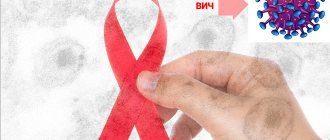Brief description of the disease
The problem of neuroses has become especially relevant today. According to official WHO data, over the past 65 years the number of registered cases has increased 24 times. During the same period, the number of mental illnesses only doubled.
The International Classification of Diseases, 10th revision (ICD-10), does not classify neurosis-like syndrome as a separate category of pathologies. Official medicine does not recognize such a concept, therefore it does not have a specific code. However, this does not mean that there is no diagnosis. It’s just that its symptoms are characteristic of many other diseases and organic lesions.
A feature of a neurosis-like state is the prerequisites for its occurrence. Pathology does not develop against the background of chronic stress or after suffering psychological trauma. On the other hand, the listed factors may play an additional role in its occurrence. The main reason is the presence of malfunctions in the body at the level of the endocrine, nervous, digestive and other systems.
Etiology of the pathological process
Most often, neurosis-like conditions arise in childhood, as well as against the background of trauma or intrauterine disorders. However, a later onset of the disease cannot be ruled out. It may be due to the following reasons:
- Mental disorders (schizophrenia, epilepsy).
- Organic brain lesions.
- Endocrine and hormonal disorders (diabetes, hyperthyroidism).
- Somatic diseases affecting the cardiovascular system, liver and gall bladder, gastrointestinal tract.
- Pathologies of an allergic nature.
The occurrence of a neurosis-like syndrome cannot be considered a consequence of the diseases listed above. On the other hand, as they arise and develop, they lead to disruptions in the functioning of certain brain structures. As a result, disruptions occur in the neurodynamics of the cortical membranes.
Clinical picture
The symptoms that characterize neurosis-like syndrome are very extensive and varied. In adults, this condition is manifested by sudden mood swings. Such a person is more often angry and irritable than friendly and calm. It is quite difficult for him to control his emotions. At the same time, fatigue and decreased concentration may occur.
Doctors include the following physical manifestations of the syndrome:
- sleep disorder;
- severe vomiting after stress;
- constipation/loose stools;
- lack of appetite, which often ends in anorexia;
- pressure changes;
- increased sweating.
For this pathology, it is not at all necessary that several symptoms occur at once. It all depends on the disease that causes it, the individual characteristics of the body and the personality of the patient himself.
Neurotic and neurosis-like syndromes combine several disorders, varied in their manifestations. Each of them has significant differences. These are asthenic, obsessive-compulsive, hypochondriacal and hysterical syndromes. Below we will consider what these pathologies are.
Features of symptoms
A neurosis-like condition in children can be suspected if the following symptoms are present:
- hyperactivity, attention deficit, increased emotional excitability;
- nightmares, fears, phobias;
- attacks of aggression, tearfulness;
- decreased tone, weakness;
- tics, stuttering, enuresis;
- constipation or diarrhea;
- nausea, vomiting;
- increased sweating or dry skin.
In adults, the syndrome has the following symptoms:
- rapid mood changes, increased anxiety and irritability, predominance of negative emotions;
- the emergence of difficulties in controlling behavior, aggression, and temper;
- vomiting and nausea during stress;
- diarrhea and constipation;
- increased fatigue;
- drowsiness, insomnia, nightmares;
- lack of appetite;
- a sharp increase and decrease in heart rate and blood pressure;
- suspiciousness, anxiety, unreasonable fears;
- sweating and tearfulness;
- enuresis.
The patient does not have to have all the symptoms on the list. In each specific case, the number and intensity of symptoms differs.
Article on the topic: What do alternating syndromes hide?
Asthenic syndrome
This neurotic state develops in stages. First, a person notices the appearance of increased fatigue, due to which he becomes emotionally unstable. Irritability quickly gives way to passivity and apathy, indifference to everything that happens around. Subsequently, a distorted perception of events and the picture of the world arises.
Also, asthenic syndrome is characterized by daytime sleepiness. Many people complain of increased sweating and severe headaches. It is with this disorder that most mental illnesses begin.
Types of neurosis-like conditions
Among neurosis-like conditions, astheno-neurotic, hypochondriacal, hysterical, and obsessive-compulsive syndrome are distinguished.
Asthenic syndrome
This syndrome does not occur suddenly, but progresses gradually. At first, the manifestations are expressed in fatigue and a feeling of tiredness, emotional instability and increased nervousness.
Then irritability disappears and is replaced by inactivity and apathy. At the same time, a person also develops indifference and an incorrect perception of the environment, a distorted assessment of events.
Patients find it difficult to tolerate loud and sharp sounds, touches, bright lights, and smells. Also characteristic features are nighttime insomnia and daytime sleepiness, excessive sweating, constant attacks of headaches, heart pain, a constant feeling of tension and anxiety. The patient's condition becomes worse with changing weather and climatic conditions.
This syndrome is often the onset of many mental illnesses, but can also be observed during treatment for somatic and infectious diseases.
Obsessive-compulsive syndrome
The name itself suggests that it is associated with obsessive states. The patient may be subject to obsessive thoughts, fears, addictions, strange rituals, and uncontrolled movements.
The patient understands the absurdity of his conditions and experiences, but cannot cope with them on his own. In some cases, it is possible to get rid of obsessions with the help of self-control, but often these conditions return again and seeking medical help cannot be avoided.
Obsessive ideas are often a symptom of neuroses, psychopathy, schizophrenia, and severe depression.
Hysterical syndrome
With this syndrome, the patient exhibits demonstrative behavior and violent emotional manifestations. All the patient’s actions, his facial expressions, speech, gestures, go along with extremely violent emotions, crying, laughing, screaming, wringing of hands, fainting, etc.
This condition should not be confused with a real hysterical attack, since with hysterical syndrome the patient pretends to have a seizure, his actions are demonstrative.
Hypochondriacal syndrome
This condition is determined by a person’s constant worries about his own health. He is afraid of getting seriously ill. Fear haunts him day and night, preventing him from concentrating on work and household chores. Unpleasant sensations in the internal organs, causeless pain in the limbs, tingling and squeezing - such complaints are usually addressed to a doctor. A patient with hypochondriacal neurosis-like syndrome begins to visit various specialists. He may demand a complete diagnosis of his health condition, ask to be cured of a non-existent illness.
If a medical examination does not reveal serious pathologies, such a person begins to accuse doctors of their incompetence. Sometimes you can hear stories about damage caused or a witchcraft curse.
Neurosis-like syndrome in children
What it is? This is a pathology, the existence of which many parents learn quite late. In children, its first symptoms appear between the ages of 2 and 7 years. Among the main causes of the disorder, doctors identify the following:
- pathologies of intrauterine development;
- smoking, drinking alcohol by a woman during pregnancy;
- diseases of the central nervous system of various etiologies;
- birth injuries.
In children, a neurosis-like disorder is considered an intermediate state between an organic disorder and neurosis itself. Sometimes it can go away on its own and without medical intervention. The child “outgrows” the illness because his brain has enormous potential for regeneration.
By about 12 years of age, the symptoms that characterize neurosis-like syndrome in children disappear. The main manifestations of the pathology are tearfulness and aggression, nightmares, and numerous phobias. The clinical picture is practically no different from that in adults. It’s still not worth waiting for the problem to be resolved on your own. Even small patients require qualified medical care.
Difference from neuroses
Neurosis-like conditions and neuroses have the same manifestations and symptoms. The difference between them lies in the nature of the appearance.
Neuroses appear as a result of prolonged stressful situations that deplete the nervous system, cause anxiety, and autonomic disorders. Neurosis-like conditions do not have psychological causes. They belong to organic diseases. Previously, they were called “organelles”.
The cause of such disorders is mild cerebral pathology caused by pathologies of intrauterine development, or resulting from previous diseases.
Diagnostic methods
If you suspect a pathology, what is the first thing to do? - determine its cause. The tactics of the therapy will subsequently depend on it. For example, the main method of treating neurosis is working with a psychologist. For neurosis-like disorders, it is ineffective.
Then, based on the existing symptoms, you will need to undergo a comprehensive examination. At the initial stage, this issue is dealt with by a neurologist. The main diagnostic methods are MRI of the brain and EEG. If the results of studies do not reveal organic lesions, most likely there is a common neurosis. In this case, the patient is referred to a psychotherapist or psychiatrist.
ICD-10 does not classify neurosis-like syndrome as a separate category of diseases. Moreover, it has a number of signs that can be identified during diagnosis. This disorder is characterized by abnormalities in the functioning of the brain and internal organ systems. Therefore, a consultation with a neurologist alone is indispensable. You will need the help of specialized specialists: a cardiologist, a gastroenterologist, an endocrinologist. First of all, it is necessary to identify and eliminate the root cause of the syndrome. Only then can you begin to restore the functioning of the central nervous system.
Symptoms and signs of the disorder
The symptoms of the syndrome are quite varied, and in each individual case it manifests itself individually . The most common of them in the adult population are:
- instability of emotional state, uncontrollable mood swings and tearfulness;
- complaints of constant fatigue, apathy;
- decreased appetite;
- pressure surges;
- sleep disorders;
- complaints from the gastrointestinal tract.
In children, the disease most often manifests itself in neurological abnormalities and is often confused with neurosis. Therefore, for correct diagnosis, consultation with a highly qualified specialist is necessary.
In addition, it is necessary to find the organic root cause of the disorder: without treating it, any therapy will only bring a temporary effect and will not get rid of the problem.
Symptoms of the syndrome in children are:
- increased activity, excitability, decreased concentration;
- depression, tearfulness, sometimes turning into aggressive behavior;
- anxiety at night in the form of nightmares, fears;
- fatigue, weakness;
- nervous tics, urinary incontinence and stuttering;
- deviations from the gastrointestinal tract;
- increased sweating or the opposite condition - dry skin.
To make a correct diagnosis, the patient is sent for additional examinations, which will help to first distinguish it from neurosis .
MRI and EEG of the brain are usually performed.
If there are no deviations from these studies, a preliminary diagnosis of neurosis is made and sent for consultation with a psychologist or psychotherapist.
If pathological changes are detected in the structure of the brain, then he is referred to a neurologist and other specialized specialists to diagnose the cause and prescribe further treatment.











